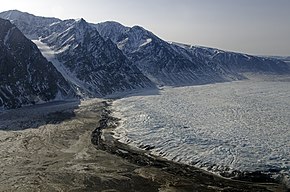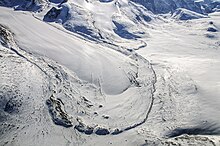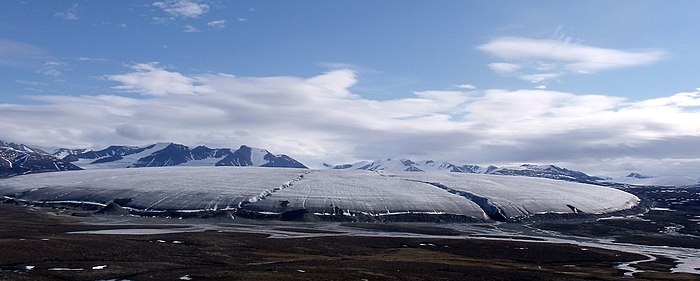What Is A Terminal Moraine


A concluding moraine, also called end moraine, is a type of moraine that forms at the final (border) of a glacier, marking its maximum advance. At this point, debris that has accumulated by plucking and abrasion, has been pushed past the front border of the ice, is driven no further and instead is deposited in an unsorted pile of sediment. Because the glacier acts very much like a conveyor belt, the longer it stays in one place, the greater the amount of material that will be deposited. The moraine is left every bit the marking point of the final extent of the ice.[i]
Formation [edit]

Terminal moraine of Penny Ice Cap, Baffin Island, Nunavut, Canada
Equally a glacier moves forth its path, the surrounding area is continuously eroding. Loose rock and pieces of bedrock are constantly being picked upwards and transported with the glacier. Fine sediment and particles are also incorporated into the glacial water ice. The accumulation of these rocks and sediment together form what is called glacial till when deposited.
Push moraines are formed when a glacier retreats from a previously deposited terminal moraine, only to push button proglacial sediment or till into an existing terminal moraine. This process tin can make the existing terminal moraine far larger than its previous size.[2]
Dump moraines occur when rock, sediment, and debris, which accumulate at the pinnacle surface of the glacier, either slide, autumn, or flow off of the snout of the glacier. The aggregating of till will grade a final moraine as the glacier retreats.[3]
Ablation moraines grade when a large slice of ice, containing an accumulation of sediment and droppings, breaks from the snout of the glacial. In one case it is separated and begins to melt, the debris found throughout this glacial piece is deposited to grade a new terminal moraine. It is of import to note that the more debris that is plant within the ice, the longer it volition take for complete melting to occur.[4]
Climate plays an important role in the germination of final moraines. Equally temperatures increase, glaciers brainstorm to retreat faster, causing more than glacial till to be deposited in the form of terminal moraines. Nonetheless, when temperatures decrease, zone of aggregating goes into overdrive. This starts a procedure where the accumulation of snow, in the zone of accumulation is greater than loss due to melting or ablation.
History [edit]
During the Terminal Glacial Maximum (LGM), the Northern hemisphere began its modern ice-age. Most of what is now Canada and northern portions of the United States were covered in ice sheets or mountain driven glaciers during the last phase of the Pleistocene Epoch.[v] [half-dozen] In the final 400,000 years there have been roughly four major glacial events.[7] Prove of these separate events is institute non only in water ice cores, but too in the glacial till that was deposited.
Rocks and sediment not native to one expanse could be found in a region completely strange to that from which they were formed. This is the result of a prior terminal moraine being picked up and deposited past a newer glacial outcome. The terminal moraines resulting from the Final Glacial Maximum are the virtually advisory features about glacial advance still present today.
Effects on landscape [edit]

Davidson Glacier, Alaska. There is a glacier-fed lake in addition to the formation of a small channel heading in the southeast direction.
During glacial retreat, meltwater flows in the opposite direction of the retreat, causing braided streams and channels to form. A terminal moraine creates a barrier helping to trap water in a newly-formed glacial lake. The positioning of the lake resulted from non but subsidence, simply as well the terminal moraine providing the foundation for the wall that holds the h2o in identify. While the terminal moraine consists of a long mound of stone and sediment which forms a construction that appears to exist a bulwark for h2o, there are still ways for the water to menstruation through. H2o makes its way through glacial till to class streams and channels.
Another landscape feature formed by final moraines are kettle lakes. These are produced during glacial recession when boulders or blocks of ice are left in identify as the glacier recedes from the newly deposited terminal moraine. As the ice boulders melt, they begin to pool to course kettle lakes in the glacial outwash plain.
Furnishings on vegetation [edit]
The concluding moraine is the furthest point of disturbed sediment, which is formed into a long mound outlining the front border of the glacier. This mound typically consists of a large quantity of rocks and boulders along with sediment, and tin can combine to attain a height of multiple meters.[8] The process of uplifting and moving these large rocks and boulders negatively affects the local vegetation by either crushing them or contributing to the process of the glacier plowing the topsoil, which removes the vegetation from the soil completely, including the root systems. In this area of disturbed land, it is difficult for new vegetation to grow. Immediately beyond the terminal moraine is the glacial outwash plainly, covered in a layer of sediment, with braided streams formed from the meltwater. Hither, one-time vegetation is buried by the sediment, but new vegetation can still survive relatively well as long as it can acquire meltwater from the now receding glacier.
Examples [edit]
Terminal moraines are one of the most prominent types of moraines in the Chill. 1 notable last moraine is Trollgarden in Norway, once idea to be magically synthetic past trolls.
In North America, the Outer Lands is a name given to the terminal moraine archipelago of the northeastern region of the United states of america (Cape Cod, Martha's Vineyard, Nantucket, Block Isle and Long Island). Co-ordinate to geologist George Frederick Wright some of the virtually prominent examples of terminal moraines on Long Isle are "the virtually remarkable in the globe".[9] Other prominent examples of concluding moraines are the Tinley Moraine and the Valparaiso Moraine, possibly the all-time examples of terminal moraines in North America. These moraines are most clearly seen southwest of Chicago.
In Europe, virtually all the terrain in the central Netherlands is fabricated up of an extended final moraine. In Switzerland, alpine terminal moraines can be found, 1 striking example being the moraine at the end of the valley of the Forno Glacier in the south-eastern canton of Graubünden near St. Moritz and the Italian edge.
In New Zealand the Franz Josef Glacier on the West Declension has created the terminal moraine chosen the Waiho Loop.

Run across also [edit]
- Glacial landform
- Listing of glacial moraines
- Oak Ridges Moraine
- Outwash manifestly
- Postglacial rebound
- Button moraine
- Trafalgar Moraine
References [edit]
- ^ H.-East. Reineck; I. B. Singh (six December 2012). Depositional Sedimentary Environments: With Reference to Terrigenous Clastics. Springer Science & Business concern Media. pp. 170–. ISBN978-three-642-96291-two.
- ^ Bendle, Jacob. "Moraine Germination". Antarctic Glaciers.
- ^ Bendle, Jacob. "Moraine Formation". Antarctic Glaciers.
- ^ Bendle, Jacob. "Moraine Formation". Antarctic Glaciers.
- ^ Stanley, Steven Thousand.; Luczaj, John A. (2015). Globe System History. New York: W.H. Freeman & Company.
- ^ "How does present glacier extent and sea level compare to the extent of glaciers and global bounding main level during the Last Glacial Maximum (LGM)?". USGS.
- ^ Hashemite kingdom of jordan, Thomas H.; Grotzinger, John P. (2012). The Essential Globe. New York: West.H. Freeman & Visitor.
- ^ Winkler, Stefan (2021), Beylich, Achim A. (ed.), "Terminal Moraine Formation Processes and Geomorphology of Glacier Forelands at the Selected Outlet Glaciers of Jostedalsbreen, Southward Norway", Landscapes and Landforms of Kingdom of norway, World Geomorphological Landscapes, Cham: Springer International Publishing, pp. 33–69, doi:x.1007/978-iii-030-52563-7_3, ISBN978-3-030-52562-0, S2CID 224993369, retrieved 2020-11-24
- ^ Wright, G. Frederick (1889). The Ice Historic period in Due north America. D. Appleton and Visitor. pp. 176.
What Is A Terminal Moraine,
Source: https://en.wikipedia.org/wiki/Terminal_moraine
Posted by: ellingtonmorold90.blogspot.com


0 Response to "What Is A Terminal Moraine"
Post a Comment